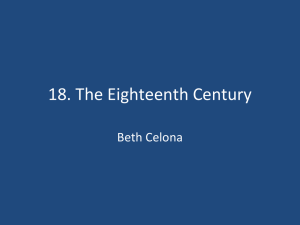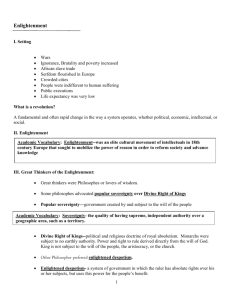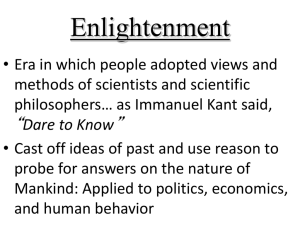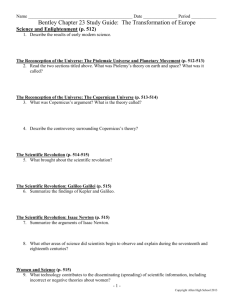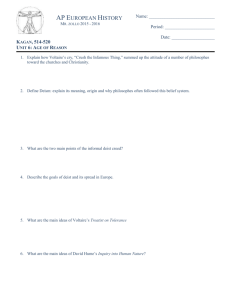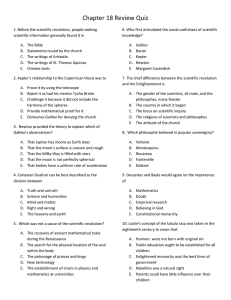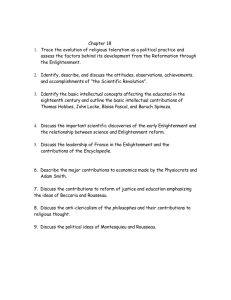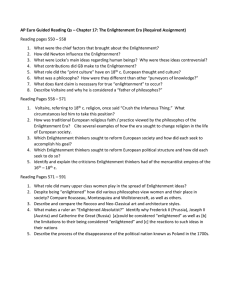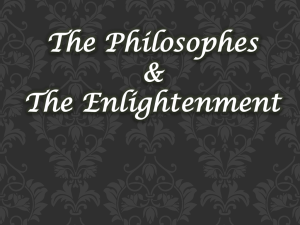Scientific Revolution & Enlightenment Worksheet
advertisement
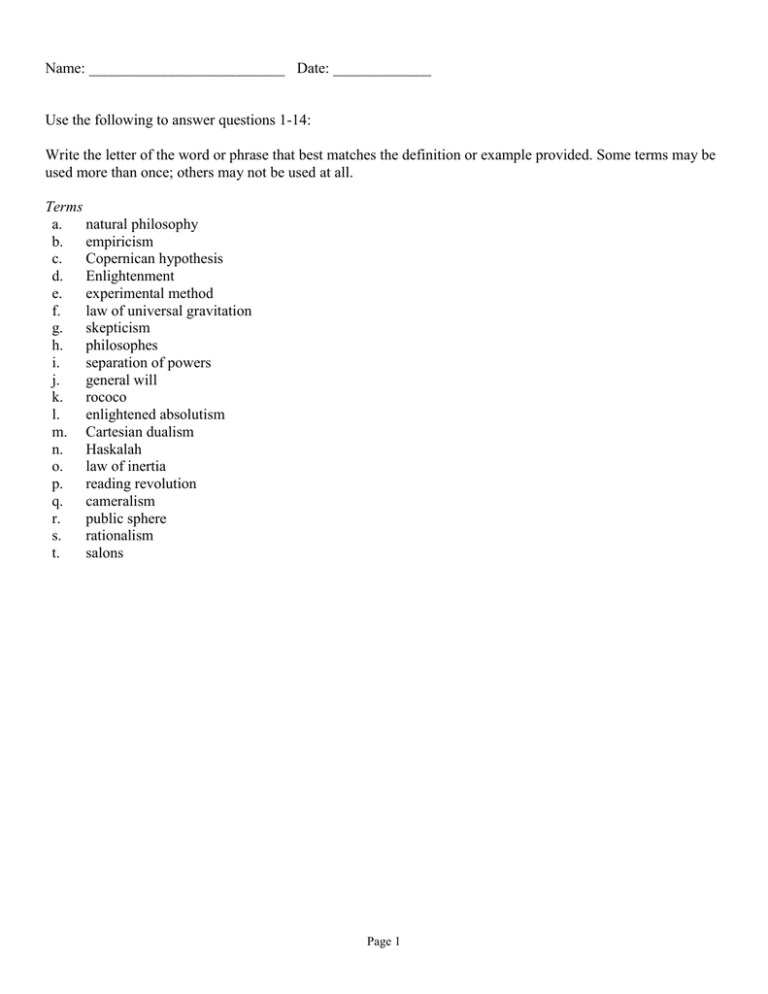
Name: __________________________ Date: _____________ Use the following to answer questions 1-14: Write the letter of the word or phrase that best matches the definition or example provided. Some terms may be used more than once; others may not be used at all. Terms a. natural philosophy b. empiricism c. Copernican hypothesis d. Enlightenment e. experimental method f. law of universal gravitation g. skepticism h. philosophes i. separation of powers j. general will k. rococo l. enlightened absolutism m. Cartesian dualism n. Haskalah o. law of inertia p. reading revolution q. cameralism r. public sphere s. rationalism t. salons Page 1 Page 2 1. The idea that the sun, not the earth, was the center of the universe. 2. A secular, critical way of thinking in which nothing was to be accepted on faith, and everything was to be submitted to reason. 3. Newton's law that all objects are attracted to one another and that the force of attraction is proportional to the object's quantity of matter and inversely proportional to the square of the distance between them. 4. Regular social gatherings held by talented and rich Parisian women in their homes, where philosophes and their followers met to discuss literature, science, and philosophy. 5. An early modern term for the study of the nature of the universe, its purpose, and how it functioned; it encompassed what we would call “science” today. 6. The approach, pioneered by Galileo, that the proper way to explore the workings of the universe was through repeatable experiments rather than speculation. 7. View that monarchy was the best form of government, that all elements of society should serve the monarch, and that, in turn, the state should use its resources and authority to increase the public good. 8. A law formulated by Galileo that stated that motion, not rest, is the natural state of an object, that an object continues in motion forever unless stopped by some external force. 9. Term coined by historians to describe the rule of eighteenth-century monarchs who, without renouncing their own absolute authority, adopted Enlightenment ideals of rationalism, progress, and tolerance. 10. A popular style in Europe in the eighteenth century, known for its soft pastels, ornate interiors, sentimental portraits, and starry-eyed lovers protected by hovering cupids. 11. Descartes's view that all of reality could ultimately be reduced to mind and matter. 12. The Jewish Enlightenment of the second half of the eighteenth century, led by the Prussian philosopher Moses Mendelssohn (1729–1786). 13. A theory of inductive reasoning that calls for acquiring evidence through observation and experimentation rather than reason and speculation. 14. The influential intellectual and cultural movement of the late seventeenth and eighteenth centuries that introduced a new worldview based on the use of reason, the scientific method, and progress. Page 3 15. Which powers participated in the partitioning of Poland in the late eighteenth century? A) Prussia, Russia, and Austria B) The Ottoman Empire, Russia, and Prussia C) Italy, Austria, and Russia D) Sweden, Prussia, and Russia E) Sweden, Saxony, and Austria 16. The discipline of natural philosophy focused on A) specific natural laws that governed all matter in the material universe. B) fundamental questions about the nature, purpose, and function of the universe. C) the application of ancient philosophy to theological questions. D) theological principles that can be discovered in the study of nature. E) the investigation of non-Western philosophy and religion in the context of Christian doctrine. 17. The scientific revolution drew on all of the following for its origins except A) the establishment of universities and their partial practice of free inquiry. B) the recovery of ancient texts in the Renaissance. C) Arabic commentaries on mathematics and studies of nature. D) efforts to solve problems of navigation. E) efforts to prevent a recurrence of the Black Death. 18. Which of the following correctly characterizes the response of various religious perspectives to Copernicus's hypothesis? A) The Catholic Church declared Copernicus a heretic, while Protestant faiths believed that the hypothesis had no bearing on Christian teaching. B) Lutheran and Catholic clerics rejected Copernicus, while Calvinists embraced the new interpretation as a new foundation for the heavens. C) Calvin and Luther condemned Copernicus, while Catholic reaction was mild at first and only declared his hypothesis false in the seventeenth century. D) The Catholic Church accepted the new science as the product of a faithful cleric, while Luther and Calvin rejected it as the product of Catholic heresy. E) Lutheran and Catholic officials rejected Copernicus's hypothesis as heretical to a literal interpretation of scripture, while Calvinists recognized a more modern approach to truth and adopted it. 19. Johannes Kepler believed that the elliptical orbit of planets A) could not be sustained, for they violated the perfection of circular orbits. B) demonstrated the presence of Satan's disruptive influence in the universe. C) made the heavens subject to violent corrections that produced earthquakes on earth. D) were interspersed with epicycles and deferents. E) produced a musical harmony of heavenly bodies. Page 4 20. What was the primary goal of Galileo's experimental method? A) To identify the fundamental laws guiding nature rather than issues of theology B) To discover what did occur in nature rather than to speculate on what should occur C) To expose how the workings of nature demonstrate the presence of God D) To uncover the hidden forces that directed nature and that humans could manipulate E) To produce benefits for humankind rather than seek abstract knowledge 21. How did Isaac Newton's law of gravity bring the Scientific Revolution to maturity? A) Newton demonstrated that the biological and physical properties of nature operated by different principles. B) Newton proved that the workings of nature could be understood without reference of God. C) Newton showed that the investigation of nature had significant limits as a form of knowledge. D) Newton synthesized mathematics with physics and astronomy to demonstrate that the entire universe was unified into one coherent system. E) Newton provided bodies of evidence that proved the existence of God. 22. Soft pastels, ornate interiors, and sentimental portraits are all characteristics of the style known as A) classicalism. B) neoclassicalism. C) baroque. D) rococo. E) romanticism. 23. Copernicus's theory of the universe A) destroyed the distinction between earthly and heavenly worlds. B) was endorsed by John Calvin. C) postulated a sun-centered view of the universe. D) strengthened the Ptolemaic theory of the universe. E) used epicycles to explain planetary motion. 24. The most influential aspect of René Descartes' theories of nature was that A) spiritual forces were infused throughout nature. B) mind and matter could be reduced to the same substance. C) secure knowledge required the use of inductive reasoning. D) only through our senses can we be sure of the world outside of us. E) the universe functioned in a mechanistic fashion. Page 5 25. Francis Bacon formalized the research methods of Tycho Brahe and Galileo into a theory of reasoning known as A) dualism. B) empiricism. C) occultism. D) naturalism. E) materialism. 26. How did the governments respond to the new science? A) States viewed new scientific communities as a threat to their control of knowledge. B) States rejected the new science as a threat to their religious foundations. C) States established academies of science to support and sometimes direct scientific research. D) States supported and defended the complete freedom of the scientist against religious officials. E) States challenged scientists to demonstrate the value of their research. 27. All of the following correctly characterize the role of women in the new science except A) in Italy, universities offered positions to women. B) women were well involved in informal scientific communities, attending salons and participating in scientific experiments. C) most new academies that furnished professional credentials did not accept female members. D) women worked as illustrators and model makers. E) women were forbidden from publishing learned treatises. 28. How did the scientific revolution affect the economy in the seventeenth century? A) The new science led to a wide expansion in the use of machinery in manufacturing. B) The new science had few practical economic applications. C) The new science expanded living standards by creating greater wealth. D) Improved medical knowledge allowed for a healthier, more productive workforce. E) The scientific method was applied to manufacturing to create more efficient manufacturing techniques. 29. Why did scientists find that Protestant countries were more conducive to their work, especially after 1640? A) Protestant countries generally lacked a strong religious authority capable of censoring or suppressing scientific work that challenged religious doctrine. B) Protestant countries embraced the idea of science because it was seen as challenging the doctrines of the Catholic Church. C) Protestant countries increasingly turned toward secular approaches to knowledge. D) Protestant countries were more influenced by Enlightenment thought. E) Protestant countries rejected literal interpretations of scripture that inhibited scientific progress. Page 6 30. In his Essay Concerning Human Understanding, John Locke claimed that A) sovereign authority rests in the hands of the people. B) all people are born with certain ideas and ways of thinking. C) human development is determined by education and society. D) people are born corrupt and society must reeducate them. E) governments are formed by contracts among free individuals. 31. What core concept of the Enlightenment was the most important and original? A) The methods of natural science should be used to examine all aspects of life. B) The scientific method could discover the laws of human society. C) Human beings could create better societies and better people. D) God has no role in the workings of the universe. E) Reason involved logical patterns of thoughts that could lead one to deduce truths. 32. In general, what was Voltaire's attitude toward government? A) He believed in democracy, like most philosophes. B) He believed that a good monarch was the best one could hope for. C) He saw the despot or autocrat as designated by God. D) He believed in enlightened despotism as long as he could be the despot. E) He believed in enlightened theocracy. 33. Rousseau believed that A) women should play an active role in public life. B) women were best suited to a passive role in social relations. C) civilization was the foundation of freedom. D) without rational thought, human society would crumble. E) enlightened absolutism was the best of all possible forms of government. 34. According to its editor, the fundamental goal of the Encyclopedia was to A) popularize the scientific revolution. B) improve the material life of Europeans. C) “change the general way of thinking.” D) undermine French absolutism. E) overthrow the king. 35. Madame du Châtelet A) believed that women's limited contribution to science was the result of unequal education. B) was the first woman admitted into the Royal Academy of Sciences. C) was the powerful mistress of Louis XV. D) inspired Jean-Jacques Rousseau's ideas on education and emotion. E) invented a steam engine. Page 7 36. Rousseau's concept of the general will asserts that A) enlightened monarchs protect the interests of the entire society and should be relied on for reform. B) the people's political wishes can be conveyed only by direct democracy. C) the authentic, long-term needs of the people can be correctly interpreted by a far-seeing minority. D) sovereignty resides in the monarchy. E) public opinion polling can be a valuable support to democracy. 37. How did Enlightenment thinkers differ from those of the Middle Ages and Renaissance? A) Enlightenment thinkers focused on worldly matters, while the Middle Ages and Renaissance only focused on concepts of sin and salvation. B) Enlightenment thinkers rejected the basic tenets of Christianity and embraced a vision of a world without God. C) Enlightenment thinkers drew inspiration from classical antiquity, whereas the Middle Ages and Renaissance focused on the Bible. D) Enlightenment thinkers relished artistic production, while the Middles Ages and Renaissance focused on penance and prayer. E) Enlightenment thinkers believed that thought had progressed far beyond that of antiquity, which demonstrated the possibility of human progress. 38. A striking feature of the salons was that A) clerics were banned. B) philosophes, nobles, and members of the upper middle class intermingled. C) they were often sponsored by the government. D) members of the working classes often attended. E) their main purpose was making marriage matches between poor nobles and wealthy commoners. 39. The Enlightenment reached its highest development in France for all of the following reasons except A) France had the highest literacy rates in Europe. B) French was the international language of the educated classes. C) France was the largest and most populous country in Europe. D) French intellectuals had more freedoms than those in Eastern and East-Central Europe. E) French philosophes sought to reach a large audience of elites. 40. How did the philosophes evade the work of censors? A) They bribed censors to approve publication of their works. B) They filled their writings with satire and double meanings. C) They published works and then claimed to have had them approved. D) They relied on friendly censors to approve publication of their works. E) They published from monasteries not subject to censorship. Page 8 41. In Persian Letters, what did the Baron de Montesquieu use to symbolize Eastern political tyranny? A) A galley ship in the Mediterranean B) A slave plantation in the Caribbean C) The oppression of women in a Persian harem D) Native Americans forced off of their land E) Eunuchs at the Chinese imperial court 42. The idea of the public sphere that emerged during the Enlightenment refers to A) a government bureau that regulated the work of the philosophes. B) an idealized space where individuals gathered to discuss social and political issues. C) the marketplaces at which peasants gathered to gossip and share news. D) the spaces in the royal courts where commoners could observe the king and the court could hold ceremonies. E) the practice of legislatures to permit private citizens to make addresses before the gathered deputies. 43. The enlightened policies of Frederick II of Prussia included all of the following except A) freeing the Prussian serfs. B) abolishing the torture of prisoners. C) permitting scholars wide latitude to publish what they wished. D) promoting schools. E) religious toleration. 44. Catherine the Great of Russia came to power in 1762 through A) inheritance of the throne from her mother Elizabeth. B) an invitation from the Russian senate to rule. C) Frederick II of Prussia's invasion of Russia. D) a military coup. E) election by the boyars. 45. Maria Winkelmann was the first woman to A) study natural philosophy. B) study early scientific law. C) discover a comet. D) criticize Locke and Hobbs. E) publish 21 works under her own name. Page 9 Answer TWO each question with three or four sentences. 46. What do the ideas of Johannes Kepler demonstrate about the origins of modern science? 47. What was the purpose and effect of the Encyclopedia: The Rational Dictionary of the Sciences, the Arts, and the Crafts? 48. How did Jean-Jacques Rousseau differ from most of the other philosophes? Page 10 Answer ONE of the following questions in a few paragraphs. Include specific examples that support your thesis and conclusions. 49. Some monarchs of the eighteenth century have been called enlightened despots. Who were these rulers? What did their contemporaries mean when they called them enlightened? How have historians treated these rulers and their policies? Were they really enlightened? Explain your answer. 50. The scientists of the seventeenth century constructed a new worldview; the philosophes of the eighteenth century popularized it. How? Why did the philosophes pursue this effort? Page 11 Page 12
